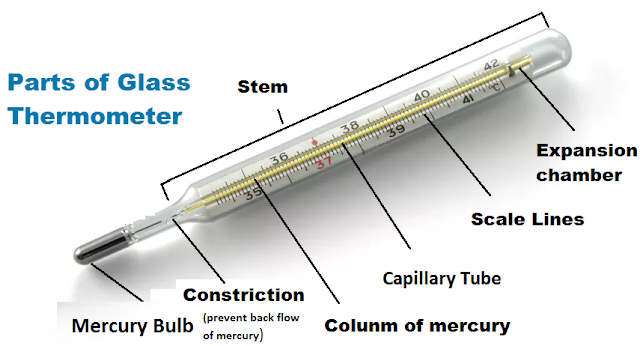Clinical or Medical
Thermometer
A medical thermometer/ clinical thermometer is a device that is used to measure the temperature of a body.
A glass thermometer consists of; a stem (long part) and bulb (containing a small amount of mercury).
Vital signs
help detect or monitor a basic health conditions. The Vital signs include; TPR (Body
Temperature, Pulse, Respiration) and BP.
Parts
of Thermometer
The parts of the clinical thermometer are

1.
Stem
The stem is a longer part of the glass thermometer.
2.
Mercury Bulb
The bulb of the clinical thermometer is spherical in shape to
store the mercury and is usually made of stainless steel.
The bulb is the lowest part of the glass thermometer, which acts as
a reservoir to hold mercury.
It contains a small amount of mercury. Mercury is a metal, at the ordinary temperature, it is in liquid form. Mercury expands in response to heat.
If the temperature
is high then mercury in the bulb moves up the capillary tube.
Mercury leaves the bulb, when the temperature rises and when
the temperature descends, the mercury returns to deposit inside the bulb.
3.
Capillary tube
The capillary or stem is the tube of the mercury thermometer
through which the mercury flows.
The capillary tube is present inside the glass thermometer, and
it is connected to the bulb.
The capillary tube is the long cylindrical tube in a mercury
thermometer that is connected to the bulb.
When the temperature rises up, the mercury flows up the
capillary.
Where capillary tube ends, after that section known as the
expansion chamber.
4.
Expansion chamber
The expansion chamber of the mercury thermometer is found at
the top of the capillary.
The expansion chamber function is to form a larger volume. If
the maximum temperature scale is exceeded, then through which the mercury can
fill.
5. Scale
lines
Scale line in thermometer is divisions of equal length
(degrees) marked on the thermometer that indicate the units of measurement. It depends
on the type of thermometer that can have ° F or ° C.
When the temperature increases, the mercury inside the bulb
rises and when cool, it goes down.
Scale line shows how far the mercury rises and goes down, marks
on the body of the thermometer indicate the temperature level.
Know here normal
body temperature range.
6. Constriction
Constriction in the thermometer prevents mercury from backflow into the bulb when the reading is being taken.
The constriction part is narrower
than the stem; it causes the mercury to slow down and gives the user the
necessary time to read the temperature reached.
Check out here parts
of Stethoscope.
Types of Thermometer
There are different types of thermometer are-
1. Digital thermometers
2. Ear (or tympanic) thermometers
3. Infrared thermometers
4. Strip-type thermometers
5. Mercury thermometers
6. App-based thermometer
7. Pacifier thermometer
1. Digital thermometers
Digital thermometers work by using heat sensors that determine
body temperature and display reading numerically
on the digital screen.
Digital thermometers can be used to take temperature readings
in the mouth, rectum, or armpit.
Oral temperature can be measured
by either a digital or mercury thermometer.
2. Ear (or tympanic) thermometers
Ear
thermometers/ Tympanic thermometers measure the temperature inside the ear canal
through infrared ray technology. It is put in the
child's ear.
3. Infared thermometers
Infared thermometers use
an infrared scanner to measure temperature.
An infared thermometer can be used
on both the forehead and wrist areas.
The forehead thermometer uses infrared
sensors to measure the temperature of the superficial temporal artery.
4. Strip-type thermometers
The use of Strip-type
thermometers is on the forehead.
A temperature strip/ plastic strip thermometer is a type of thermometer; that contains heat-sensitive material in a plastic strip that changes color to indicate different temperatures.
5. Mercury thermometers
Mercury thermometers are mercury-in-glass thermometers. Do not use mercury thermometers; they can break, releasing small fragments of glass and highly poisonous mercury.
6.
App-based thermometer
Smartphone apps use the temperature sensors in the phone
to show the temperature near your phone.
7. Pacifier thermometer
A Pacifier thermometer helps to
measure the body temperature in infants. If a baby comes down with a fever it changes color in stages from blue to
red, which shows a fever.
Use of Clinical Thermometer
A clinical Thermometer is used to
measure the body temperature.
Know the parts
of a Sphygmomanometer that are used to measure blood pressure.
How
to Disinfection of Clinical Thermometer?
Clean your thermometer before and after you use it with
either rubbing alcohol or lukewarm soapy water, then rinse with cool water. The
clinical thermometer should keep in a safe place, away from the child's reach.
Disinfection Rule
Less contaminated to more
contaminated
Disinfected the thermometer with an alcohol swab or cotton
ball dipped in alcohol clean within one stroke.
Before
Use
Blub to stem
Disinfected the thermometer with an alcohol swab or cotton
ball dipped in alcohol and rubbed Blub to stem within one stroke.
After Use
Stem to bulb
Disinfected the thermometer with an alcohol swab or cotton
ball dipped in alcohol and rubbed Stem to bulb within one stroke.








0 Comments